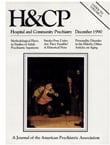Mental Health Home Visits to Nonhomebound Elderly
Abstract
A caseload of 86 patients in a geriatric home visiting service was examined to identify the characteristics that determine why certain geriatric patients receive home visits. Only about a third of the patients were physically homebound. The rest left home for at least some medical care and sustenance, and half of those patients went out for everything but mental health care. Among the 29 nonhomebound patients, few were selfreferred, and generally the patient's clinician was more concerned than the patient about the continuation of treatment, findings that suggest that the concern of others was a determining factor in provision of home-based care. The most common problems among the nonhomebound elderly in the caseload were paranoia, depression, and physical frailty.
Access content
To read the fulltext, please use one of the options below to sign in or purchase access.- Personal login
- Institutional Login
- Sign in via OpenAthens
- Register for access
-
Please login/register if you wish to pair your device and check access availability.
Not a subscriber?
PsychiatryOnline subscription options offer access to the DSM-5 library, books, journals, CME, and patient resources. This all-in-one virtual library provides psychiatrists and mental health professionals with key resources for diagnosis, treatment, research, and professional development.
Need more help? PsychiatryOnline Customer Service may be reached by emailing [email protected] or by calling 800-368-5777 (in the U.S.) or 703-907-7322 (outside the U.S.).



